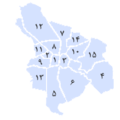This article has multiple issues. Please help improve it or discuss these issues on the talk page . (Learn how and when to remove these messages)
|
| Isfahan city |
|---|
 |
The following is a timeline of the history of the city of Isfahan, Iran.
This article has multiple issues. Please help improve it or discuss these issues on the talk page . (Learn how and when to remove these messages)
|
| Isfahan city |
|---|
 |
The following is a timeline of the history of the city of Isfahan, Iran.
| History of Iran |
|---|
 |
| Timeline |
{{cite web}}: Missing or empty |url= (help) Retrieved 8 February 2017{{cite web}}: CS1 maint: archived copy as title (link)This article incorporates information from the Persian Wikipedia and German Wikipedia.
Published prior to 19th century
{{citation}}: ISBN / Date incompatibility (help)Published in the 20th century
{{citation}}: CS1 maint: location missing publisher (link)Published in the 21st century
Primary-source materials related to the social and cultural history of women's worlds in Qajar Iran
Image Database of Persian Historical Documents from Iran and Central Asia up to the 20th Century